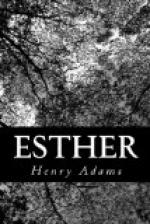Chapter IV
St. John’s church was a pleasant spot for such work. The north transept, high up towards the vault of the roof, was still occupied by a wide scaffold which shut in the painters and shut out the curious, and ran the whole length of its three sides, being open towards the body of the church. When Esther came to inspect her field of labor, she found herself obliged to choose between a space where her painting would be conspicuous from below, and one where, except in certain unusual lights, it could hardly be seen at all. Partly out of delicacy, that she might not seem to crowd Wharton’s own work into the darkness; partly out of pure diffidence, Esther chose the least conspicuous space, and there a sort of studio was railed off for her, breast high, within which she was mistress. Wharton, when painting, was at this time engaged at some distance, but on the same scaffolding, near the nave.
The great church was silent with the echoing silence which is audible. Except for a call from workmen below to those at work above, or for the murmur of the painters as they chatted in intervals of rest, or for occasional hammering, which echoed in hollow reverberations, no sound disturbed repose. Here one felt the meaning of retreat and self-absorption, the dignity of silence which respected itself; the presence which was not to be touched or seen. To a simple-minded child like Catherine Brooke, the first effect was as impressive as though she were in the church of St. Mark’s. She was overwhelmed by the space and silence, the color and form; and as she came close to Wharton’s four great figures of the evangelists and saw how coarsely they were painted, and looked sheer down from them upon the distant church-floor, she thought herself in an older world, and would hardly have felt surprised at finding herself turned into an Italian peasant-girl, and at seeing Michael Angelo and Raphael, instead of Wharton and Esther, walk in at the side door, and proceed to paint her in celestial grandeur and beauty, as the new Madonna of the prairie, over the high altar.
This humility lasted several minutes. Then after glancing steadfastly at Wharton’s figure of John of Patmos which stood next to that which Esther was to paint, Catherine suddenly broke out:
“Shade of Columbus! You are not going to make me look like that?”
“I suppose I must,” replied Esther, mischievously.
“Lean and dingy, in a faded brown blanket?” asked Catherine in evident anguish.
“So Mr. Wharton says,” answered Esther, unrelentingly.
“Not if I’m there,” rejoined Catherine, this time with an air of calm decision. “I’m no such ornery saint as that.”




